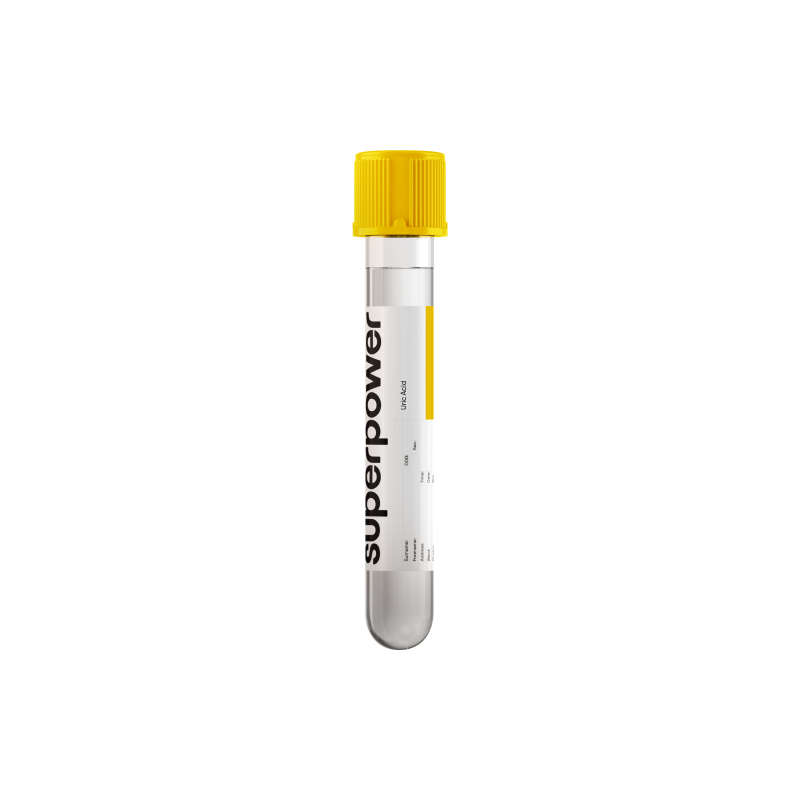Get precise insights into joint comfort, kidney stone risk, and metabolic health balance.
Key Benefits
- Check your blood uric acid to gauge gout risk and urate balance.
- Spot silent hyperuricemia before it causes painful gout.
- Clarify joint symptoms by supporting or lowering suspicion for gout.
- Guide urate-lowering therapy; track progress toward a target under 6 mg/dL.
- Protect kidneys by flagging levels that raise uric acid stone risk.
- Flag drug effects; diuretics and low-dose aspirin can raise uric acid.
- Flag cardiometabolic patterns; high urate often accompanies hypertension, obesity, and insulin resistance.
- Best interpreted with symptoms, joint exam, kidney function, and medications list.
What is Uric Acid?
Uric acid (urate) is the body’s final breakdown product of purines—the building blocks found in DNA/RNA and certain foods. Most uric acid is made in the liver and intestinal lining when an enzyme converts purine remnants (hypoxanthine and xanthine) into uric acid (xanthine oxidoreductase/xanthine oxidase). Humans lack the enzyme that would further degrade it (uricase), so it circulates in the blood mostly as urate, then is removed primarily by the kidneys, with a smaller share handled by the gut.
Biologically, uric acid is mainly a waste signal that mirrors how much purine the body is turning over and how well it is being cleared. It also acts as a notable antioxidant in the bloodstream, helping mop up reactive molecules that can damage cells. Its concentration depends on the balance between production and elimination by the kidneys and intestines. When the blood becomes overly saturated, urate can come out of solution and form needle-like crystals (monosodium urate) in tissues. In short, uric acid reflects purine metabolism and excretion, while contributing antioxidant capacity in circulation.
Why is Uric Acid important?
Uric acid is the end-product of purine metabolism and a barometer of how the body handles cellular turnover, kidney excretion, and oxidative balance. Most is cleared by the kidneys, with a smaller share via the gut. Too little can reduce antioxidant buffering; too much can crystallize, provoking inflammation in joints and kidneys and signaling cardiometabolic strain.
Most labs place the reference range in the mid–single digits, typically lower in women (especially premenopausal) and children, and lower in early pregnancy. Values in the middle of the range are generally “sweet spot,” avoiding both oxidative deficit and crystal risk.
When uric acid runs low, it often reflects reduced production (for example inhibition of xanthine oxidase) or increased renal loss. Many people feel fine, but some may have less antioxidant reserve and, in rare genetic renal transport defects, experience exercise-induced flank pain or acute kidney stress. In neurologic disease, lower levels have been linked observationally to less antioxidant support in the central nervous system. Early pregnancy physiology naturally lowers uric acid.
When uric acid runs high, serum becomes supersaturated, allowing monosodium urate crystals to form. This triggers sudden, hot, painful gout flares, tophi over time, and uric acid kidney stones or chronic kidney tubule injury. High levels also impair endothelial nitric oxide, linking to hypertension, insulin resistance, fatty liver, and chronic kidney disease. Men tend to run higher; in pregnancy, a rise later in gestation can accompany preeclampsia.
Big picture: uric acid bridges purine metabolism, renal handling, immune activation, and vascular biology. Persistently high levels raise risk for gout, stones, and kidney decline and associate with cardiometabolic disease, while very low levels are usually benign but can unmask rare transport disorders. Keeping it mid-range supports metabolic and vascular homeostasis.
What Insights Will I Get?
Uric acid is the end-product of purine breakdown by xanthine oxidoreductase and is cleared mostly by the kidneys. It sits at the crossroads of energy turnover, redox balance, and renal handling. In blood it can act as an antioxidant, while within tissues it can drive oxidative stress and inflammation. Because of this dual role, uric acid integrates signals from metabolism, kidney function, vascular tone, and cellular turnover.
Low values usually reflect reduced purine production or increased renal loss. This can happen with low cell turnover, severe liver disease, certain genetic renal transport defects, or uricosuric medications. Most people are asymptomatic, but very low levels may indicate diminished circulating antioxidant capacity and, in rare renal tubular disorders, a tendency to exercise-induced kidney stress. Levels are naturally lower in children, women, and early pregnancy.
Being in range suggests balanced purine metabolism, effective kidney excretion, and stable redox signaling that supports vascular and metabolic homeostasis. For cardiometabolic risk, epidemiologic data generally link the lower half of the reference range to favorable outcomes, recognizing sex differences (women tend to run lower premenopause).
High values usually reflect increased production (high cell turnover, hypoxia/ATP depletion) and/or reduced renal excretion (impaired filtration, insulin resistance, diuretics). System effects include crystal formation (gout, kidney stones), endothelial dysfunction, oxidative stress, and activation of pathways that raise blood pressure and worsen glucose–lipid handling. Men typically have higher levels; values often rise after menopause and with aging. In late pregnancy, a rise can accompany hypertensive disorders.
Notes: Uric acid varies with fasting status, recent exercise, dehydration, and acute illness. Many drugs shift levels. During an acute gout flare, serum uric acid can be transiently normal. Pregnancy lowers levels early and increases them later. Lab reference intervals differ by sex and age.



.svg)



.png)
.png)
.png)
.png)








